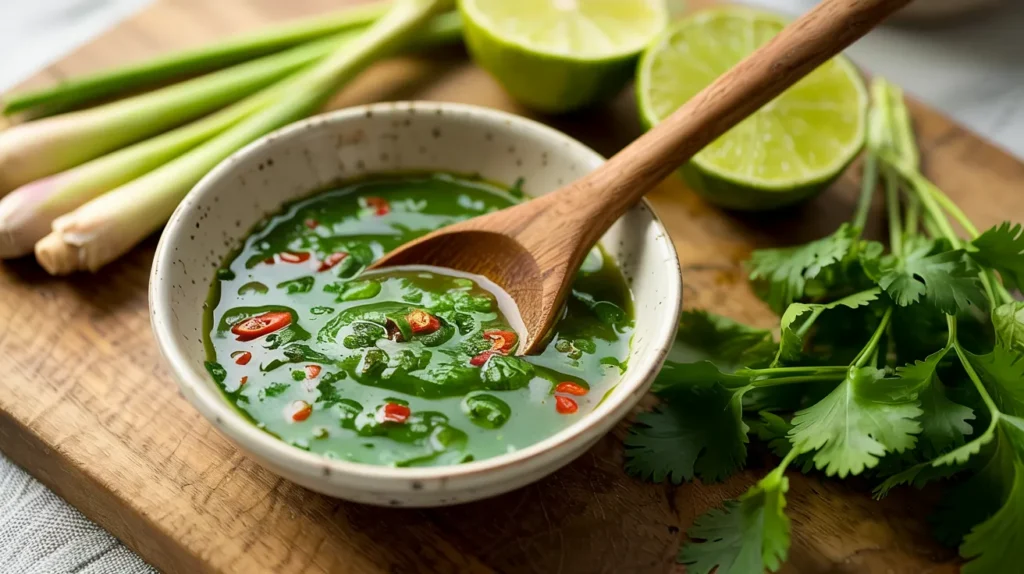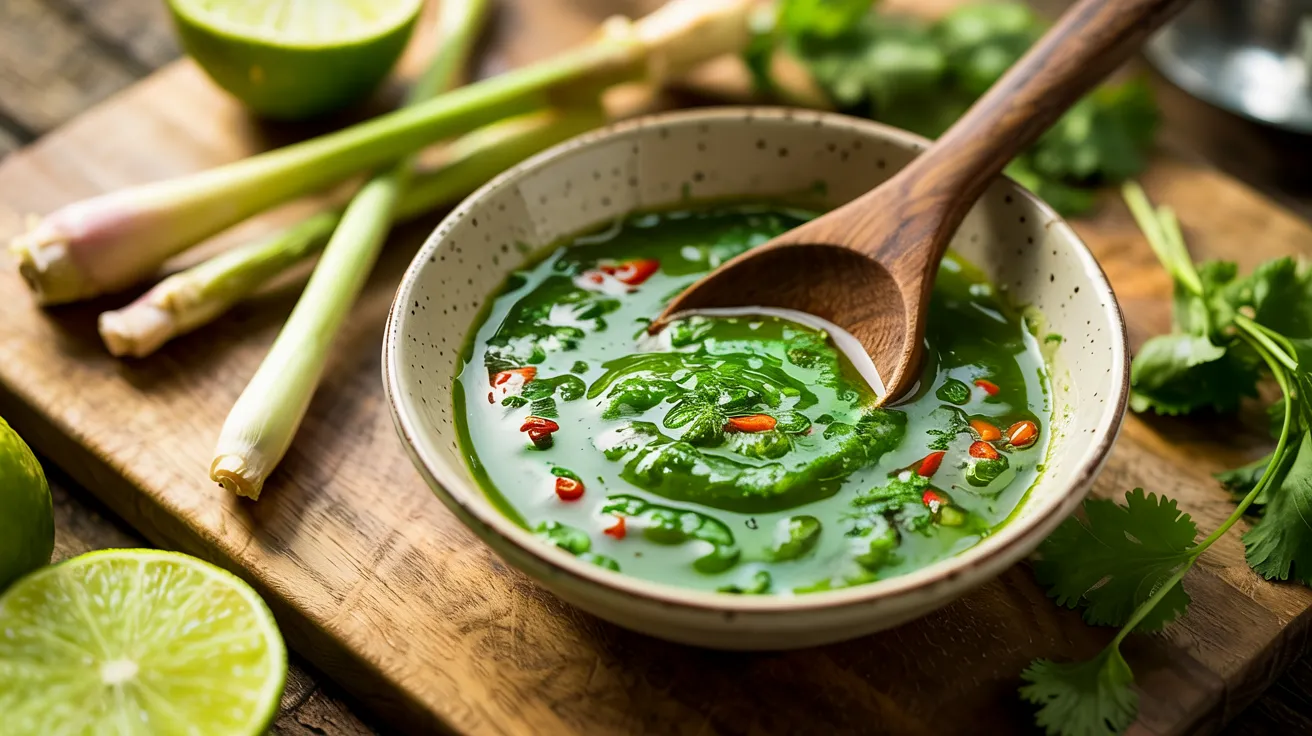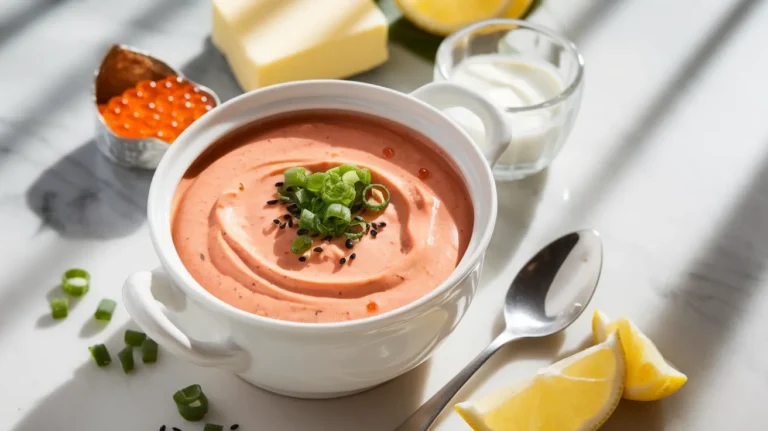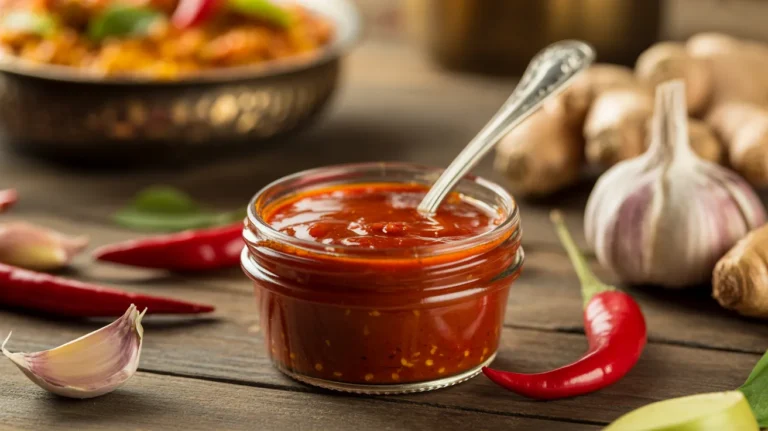Key Takeaways
- Ready in just 15 minutes with intense citrus-herbal flavor
- Versatile Lemongrass Sauce that pairs with seafood, chicken, beef or vegetables
- Stores for up to 2 weeks in the refrigerator
- Customizable heat level to suit your preference
Are you tired of the same old sauces that lack that special zing? The search ends here. This vibrant Lemongrass Sauce brings a burst of Southeast Asian flavor to any dish.
With its bright citrus notes and aromatic complexity, this Lemongrass Sauce transforms ordinary meals into culinary adventures. Best of all, it comes together in minutes with ingredients you can find at most grocery stores.
Let me show you how to create this versatile Lemongrass Sauce that will become your new secret weapon in the kitchen. Whether you’re drizzling it over grilled meats or using it as a dipping sauce, this recipe serves four people perfectly and will have everyone asking for your secret.
Nutrition Information for Lemongrass Sauce
| Nutrient | Amount per Serving | % Daily Value |
|---|---|---|
| Calories | 85 | 4% |
| Total Fat | 7g | 9% |
| Saturated Fat | 1g | 5% |
| Sodium | 390mg | 16% |
| Total Carbs | 5g | 2% |
| Fiber | 1g | 4% |
| Sugar | 2g | – |
| Protein | 1g | 2% |
Based on a 2,000 calorie diet
Equipment & Ingredients for Perfect Lemongrass Sauce
Kitchen Tools Needed
| Tool | Purpose |
|---|---|
| Food processor or blender | Puréeing sauce ingredients |
| Sharp knife | Chopping herbs and lemongrass |
| Cutting board | Prep surface |
| Measuring spoons | Accurate measurements |
| Citrus juicer | Extracting lime juice |
| Storage container | Storing leftover sauce |
Lemongrass Sauce Ingredients List
| Ingredient | Amount | Notes |
|---|---|---|
| Fresh lemongrass stalks | 3 stalks | Bottom white portions only |
| Garlic cloves | 4 medium | Peeled |
| Fresh ginger | 1-inch piece | Peeled |
| Lime juice | 3 tablespoons | Freshly squeezed |
| Fish sauce | 2 tablespoons | For umami depth |
| Rice vinegar | 1 tablespoon | Adds brightness |
| Neutral oil (canola or grapeseed) | 5 tablespoons | Emulsifies the sauce |
| Brown sugar | 1 tablespoon | Balances flavors |
| Red chili (Thai bird’s eye) | 1-2 | Adjust to taste |
| Cilantro | ¼ cup | Leaves and tender stems |
| Salt | ½ teaspoon | To taste |
Possible Substitutions for Lemongrass Sauce
- No lemongrass? Use 2 teaspoons lemon zest + 1 teaspoon grated ginger
- Vegan option: Replace fish sauce with soy sauce or coconut aminos
- No fresh lime? Use bottled lime juice in a pinch
- Sugar alternatives: Honey or maple syrup work well
- Herb options: Thai basil or mint can replace cilantro
- Mild version: Omit the chili peppers entirely
Detailed Lemongrass Sauce Instructions for Beginners
Prep Time: 10 minutes
Cook Time: 5 minutes
Total Time: 15 minutes
Servings: 4
Preparation Phase
- Prepare the lemongrass
- Find your lemongrass stalks and place them on a cutting board.
- Using a sharp knife, cut off the woody top portion (the dark green part) and discard it.
- Cut off the root end (the very bottom) and discard that too.
- Remove the tough outer layers by peeling them away with your fingers, similar to peeling an onion.
- Keep peeling until you reach the pale, softer core which is lighter in color.
- Now slice this tender white portion into very thin rounds, about ¼-inch thick.
- BEGINNER TIP: If you’re having trouble cutting the lemongrass, try smashing it first with the flat side of your knife to soften it.
- When finished, you should have about ⅓ cup of sliced lemongrass.
- Prep the garlic
- Take 4 medium garlic cloves and place them on your cutting board.
- Lay the flat side of your knife over each clove and press down firmly with your palm to crush it slightly.
- This will make the peels easier to remove.
- Peel away the papery skin from each clove.
- Roughly chop the garlic cloves into small pieces.
- BEGINNER TIP: Your pieces don’t need to be perfectly uniform since they’ll be processed later.
- Prep the ginger
- Take your 1-inch piece of fresh ginger.
- Use the edge of a spoon to scrape off the skin. This works better than a knife for the bumpy surface.
- Once peeled, slice the ginger into thin coins.
- BEGINNER TIP: Fresh ginger can be stored in the freezer and grated while frozen for future use.
- Prepare the cilantro
- Rinse your cilantro under cold water to remove any dirt.
- Gently pat dry with a paper towel or use a salad spinner.
- You don’t need to separate all the leaves from the stems – the tender stems have great flavor.
- Roughly chop about ¼ cup of cilantro (leaves and tender stems).
- BEGINNER TIP: If you don’t like cilantro, substitute with an equal amount of mint or Thai basil.
- Prepare the chili peppers
- Put on disposable gloves if you have sensitive skin.
- Slice the chili peppers in half lengthwise.
- Use the tip of your knife to scrape out the seeds and white membrane if you want less heat.
- Finely chop the chili peppers.
- BEGINNER WARNING: Wash your hands thoroughly after handling chili peppers and avoid touching your eyes or face.
- Extract the lime juice
- Roll your limes on the countertop with your palm to help release the juices.
- Cut the limes in half.
- Use a citrus juicer to extract the juice.
- Measure out 3 tablespoons of fresh lime juice.
- BEGINNER TIP: If your limes are cold, microwave them for 10 seconds to get more juice.
- Set up your equipment
- Ensure your food processor or blender is clean and properly assembled.
- Have a rubber spatula ready for scraping down the sides.
- Place a storage container nearby for the finished Lemongrass Sauce.
- Gather all your prepped ingredients so they’re within easy reach.
Assembly Steps for Lemongrass Sauce
- Combine the base ingredients
- Place your sliced lemongrass in the food processor or blender.
- Add the chopped garlic, sliced ginger, and chopped chili.
- Put the lid on securely.
- Pulse 8-10 times in short bursts (1-2 seconds each).
- Stop and remove the lid to check the texture – it should be finely chopped but not completely puréed.
- Use a spatula to scrape down the sides of the processor bowl.
- BEGINNER TIP: If you don’t have a pulse function, turn the processor on and off manually in short bursts.
- Add the wet ingredients
- Pour in the 3 tablespoons of lime juice.
- Add 2 tablespoons of fish sauce.
- Add 1 tablespoon of rice vinegar.
- Sprinkle in 1 tablespoon of brown sugar.
- Replace the lid.
- Pulse 5-6 more times to combine all ingredients.
- BEGINNER TIP: Measure each liquid ingredient separately for accuracy.
- Incorporate the oil
- Keep the processor lid on but remove the small center cap or feed tube cover.
- Turn the processor on to run continuously.
- While it’s running, slowly drizzle in the 5 tablespoons of oil through the feed tube.
- Pour in a thin stream over about 30 seconds.
- Continue processing until the mixture becomes smooth and emulsified (about 30 seconds more).
- The Lemongrass Sauce should have a slightly thick, pourable consistency.
- BEGINNER TIP: Pouring the oil in slowly helps create a smooth, well-mixed sauce.
- Finish with herbs
- Add the chopped cilantro to the processor.
- Add ½ teaspoon of salt.
- Pulse 3-4 times just to incorporate the herbs.
- The cilantro should be visible in small pieces throughout the Lemongrass Sauce.
- BEGINNER TIP: Don’t over-process at this stage or you’ll lose the fresh herb appearance.
- Taste test and adjust
- Open the processor and carefully taste a small amount of the Lemongrass Sauce.
- Ask yourself: Is it balanced? Does it need more salt, sweetness, or acidity?
- For more salt: add ¼ teaspoon at a time.
- For more sweetness: add ½ teaspoon more brown sugar.
- For more acidity: add ½ teaspoon more lime juice.
- For more heat: add a small amount of extra chopped chili.
- Pulse 2-3 times after each adjustment.
- BEGINNER TIP: Start with small adjustments and taste after each one.
Finishing Steps for Your Lemongrass Sauce
- Adjust consistency if needed
- If your Lemongrass Sauce is too thick, add 1 teaspoon of water.
- Pulse 2-3 times to incorporate.
- Continue adding water in 1 teaspoon increments until you reach your desired consistency.
- For a smoother sauce, process for an additional 30 seconds.
- For a chunkier texture, skip additional processing.
- BEGINNER TIP: The sauce will thicken slightly when refrigerated.
- Rest the sauce
- Use a rubber spatula to transfer your Lemongrass Sauce to a clean storage container.
- Cover with a lid or plastic wrap.
- Let rest at room temperature for at least 15 minutes before using.
- This resting time allows the flavors to meld together.
- BEGINNER TIP: Making this sauce a day ahead will result in even better flavor.
- Serving your Lemongrass Sauce
- After resting, give the sauce a good stir before serving.
- Serve at room temperature for the best flavor.
- Portion into small dipping bowls for individual servings.
- Garnish with a fresh cilantro leaf if desired.
- BEGINNER TIP: This sauce makes a wonderful marinade for chicken, fish, or tofu – just coat and refrigerate for 30 minutes before cooking.

Troubleshooting Your Lemongrass Sauce
Common Issues and Solutions
Problem: Sauce is too thick
Solution: Add water, 1 teaspoon at a time, until desired consistency is reached.
Problem: Too spicy
Solution: Add an extra tablespoon of brown sugar and a splash more oil to mellow the heat.
Problem: Lemongrass fibers are too tough
Solution: Ensure you’re using only the tender white parts and process longer. For an ultra-smooth sauce, strain through a fine mesh sieve after processing.
Problem: Lacks flavor depth
Solution: Add an additional tablespoon of fish sauce or try letting the sauce rest longer (even overnight) for flavors to develop.
Problem: Too tart
Solution: Balance with an additional ½-1 teaspoon of brown sugar.
Problem: Sauce separates after storing
Solution: This is normal. Simply stir well before using or give it a quick pulse in the blender.
Variations of Lemongrass Sauce
Thai-Style Lemongrass Sauce
Add 2 tablespoons of coconut milk for a creamier sauce that’s perfect for curries and soups. Check out more Asian-inspired sauces for additional ideas.
Vietnamese-Inspired Lemongrass Sauce
Add 2 tablespoons of peanut butter and reduce the oil to 3 tablespoons for a rich dipping sauce for spring rolls.
Japanese Fusion Lemongrass Sauce
Replace the fish sauce with 1 tablespoon of miso paste for an umami-rich variation that pairs beautifully with grilled vegetables.
Herb Garden Lemongrass Sauce
Add a mix of Thai basil, mint, and cilantro (½ cup total) for a garden-fresh take that’s perfect for summer dishes.
Storage & Reheating Tips for Lemongrass Sauce
Refrigeration
- Store your Lemongrass Sauce in an airtight container in the refrigerator for up to 2 weeks
- The flavor will actually intensify over the first 24-48 hours
- Allow to come to room temperature before serving for best flavor
- Stir well before using if any separation has occurred
Freezing Your Lemongrass Sauce
- Freeze in ice cube trays for perfect portion control
- Once frozen, transfer cubes to a freezer bag or container
- Label with the date and “Lemongrass Sauce”
- Keeps for up to 3 months
- Thaw overnight in the refrigerator or at room temperature for 1 hour
Uses for Leftover Lemongrass Sauce
- Stir into soups for an instant flavor boost
- Mix with mayonnaise for a gourmet sandwich spread
- Toss with noodles or rice for a quick meal
- Use as a marinade for meats or tofu
- Try it alongside homemade Chiu Chow chili sauce for a diverse flavor experience
Safety Notes & Tips for Lemongrass Sauce
Food Safety
- Always wash hands before and after handling fresh chilies
- Use a separate cutting board for herbs and aromatics
- Refrigerate Lemongrass Sauce promptly after making
- If the sauce develops an off odor or mold, discard immediately
- Use clean utensils each time you dip into the sauce container
Prep Tips for Lemongrass Sauce
- For maximum flavor extraction, bruise lemongrass stalks with the back of your knife before slicing
- Freeze unused lemongrass stalks wrapped in plastic for future use
- Make a double batch and freeze half for later use
- For a time-saving option, look for pre-minced lemongrass in tubes in the produce section
- Store lemongrass roots in a glass of water to keep fresh longer
Serving Suggestions for Lemongrass Sauce
- Drizzle over grilled fish or chicken
- Use as a dipping sauce for spring rolls or dumplings
- Toss with cold noodle salads
- Mix with mayo for a gourmet sandwich spread
- Pair with easy Szechuan sauce for a flavor-packed meal with contrasting tastes
- Use as a finishing sauce for stir-fries
- Brush onto corn on the cob for a Thai-inspired side dish
Lemongrass Sauce FAQ
Q: Can I make this Lemongrass Sauce without a food processor?
A: Yes, mince all ingredients very finely by hand and whisk together in a bowl. The texture will be chunkier but still flavorful.
Q: Is this Lemongrass Sauce gluten-free?
A: Check your fish sauce brand to ensure it’s gluten-free. All other ingredients are naturally gluten-free.
Q: How spicy is this Lemongrass Sauce?
A: With 1-2 Thai chilies, it’s moderately spicy. Adjust by reducing or increasing the amount of chili.
Q: What can I serve this Lemongrass Sauce with?
A: It’s versatile! Try it with grilled meats, seafood, rice dishes, noodles, or as a dipping sauce for spring rolls.
Q: Can I use dried lemongrass instead of fresh?
A: Fresh is strongly recommended for this sauce, but in a pinch, soak 2 tablespoons of dried lemongrass in hot water for 10 minutes, then drain before using.
Q: How do I know if my Lemongrass Sauce has gone bad?
A: Trust your senses – if it smells off, has changed color significantly, or shows any signs of mold, discard it immediately.




